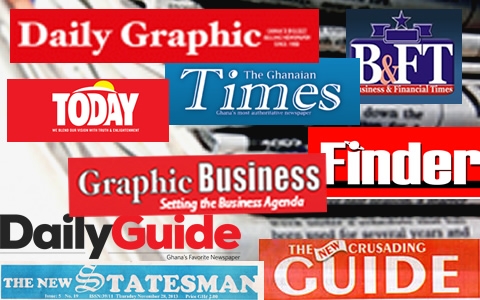The rapid depreciation of the cedi, rising prices of raw materials by producers, freight, logistics, and procurement costs from the beginning to the end have led to a dramatic rise in the prices of printing materials such as paper, ink, film and plate among others impacting newspapers negatively.
Unprecedented escalation of prices
The unprecedented escalation of prices of printing materials is collapsing the newspaper business in Ghana.
Inputs imported
The Newspaper industry is feeling the pinch very hard because all the inputs in producing newspapers are imported
Impact of cedi
The cedi which has lost over 50% of its value since the beginning of the year has made inputs for newspaper production which are all imported ridiculously expensive.
Decline in advert revenue
The make matters worse for the newspaper industry, advertising revenue which was already small has also declined significantly as companies struggle to cope with the financial crunch and slowdown in patronage.
Print media grappling with financial difficulties
The situation has exacerbated the already precarious financial difficulties print media has been grappling with.
Newsprint takes up about half the cost of publishing
While newsprint takes up about half the cost of newspaper production, other costs have been going up too.
579% rise in the price of 80 grams bond paper
The price of a rim of 80 grams of bond paper increased from GH₵380 in January to GH₵1,900 currently, representing an increase of 579% in less than a year.
612% rise in the price of 70 grams bond paper
In the same vein, the price of a rim of 70 grams of bond paper has skyrocketed by 612% rising from GH₵260 in January to GH₵1, 850 at the moment.
695% increase in the price of 60 grams bond paper
In respect of the price of a rim of 60 grams of bond paper, it jumped from GH₵220 in the beginning of the year to GH₵1,750, an increase of 695%.
108% rise in the price of newsprint
The price of a rim of newsprint measuring 30 by 40 inches rose from GH₵320 in January to GH₵520 currently, an increase of 108%.
62.5% increase in the price of a box of film
In the same vein, the price of a box of film also went up by 62.5% from GH₵120 at the beginning of the year to GH₵250 at the moment.
166% increase in the price of SM plate
The price of SM plate which was GH₵450 in January is now selling at GH₵1,200, representing 166% increase in just 10 months.
86% rise in the price of Kord plate
For Kord plate, it sold for GH₵480 in January but is currently selling at GH₵900, representing 86% spike.
83% increase in the price of Kors plate
The price of Kors plate also skyrocketed from GH₵600 in the beginning of the year to GH₵1,100, an increase of 83%.
50% increase in the price of ink
Buying Ink has also become expensive as the price of 2.5 kilogramme jumped from GH₵120 in January to GH₵180 currently which is an increase of 50% while the one kilogramme also witnessed price hike from GH₵48 in January to GH₵72 at the moment representing 50% rise.
100% rise in the price of Dampen Hose
Dampen Hose which was selling at GH₵25 in the beginning of the year recorded 100% increase to sell at GH₵50.
100% increase in the price of Cleaner
Cleaner which is used to clean the plates also went up by 100% from GH₵25 to GH₵50.
100% rise in the price of Sponge
The price of Sponge increased from GH₵12 in January to GH₵25 currently representing 100% rise.
86% increase in the price of Developer
For Developer, the price rose from GH₵8 at the beginning of the year to GH₵15, an increase of 86%.
World Association of News Publishers
In a survey conducted by World Association of News Publishers involving 75 publishers from 32 countries all over the world in July 2022, nearly 65% of publishers said they raised the price of their print newspapers in the last 12 months.
About 16% raised their prices by more than 30%
Nearly 50% saw little or no change in churn, a few even said their circulation increased and nearly 50% said they plan to raise their prices in the next 12 months.
Another 28% said they are contemplating a change.
Of those publishers that said they have raised their prices in the last 12 months, the majority have done so at a rate between 0-20%, but a significant number have been even more aggressive, 4.4% even raising theirs more than 50%.
While some publishers have experienced some significant churn after raising their prices, the majority have had churn within a manageable rate, considering the typical YoY decline in print circulation.
As news publishers around the world increase their focus (rightfully so) on the transition to a more digital and diversified future, the bridge leading to that day – print – is still the primary platform of revenue for most.
In a most recent World Press Trends report (published in early May 2022), the World Association of News Publishers estimates based on a global survey of publishers and PwC’s annual Global Media and Entertainment report data, print makes up 73% of overall income for newspapers; print circulation makes up nearly 42% of overall revenue.
Digital makes up 16.4% of total revenue, while digital circulation makes up 5.7% of overall revenue.
It is worth noting that the association reported other revenue streams in that report that totalled nearly 21% of overall revenues, a very positive development.
- Have we reaped the whirlwind? - 19 April 2025
- Fighting cocaine with the cross - 18 April 2025
- Galamsey, Cocaine: of truths, errors and the priest - 18 April 2025




